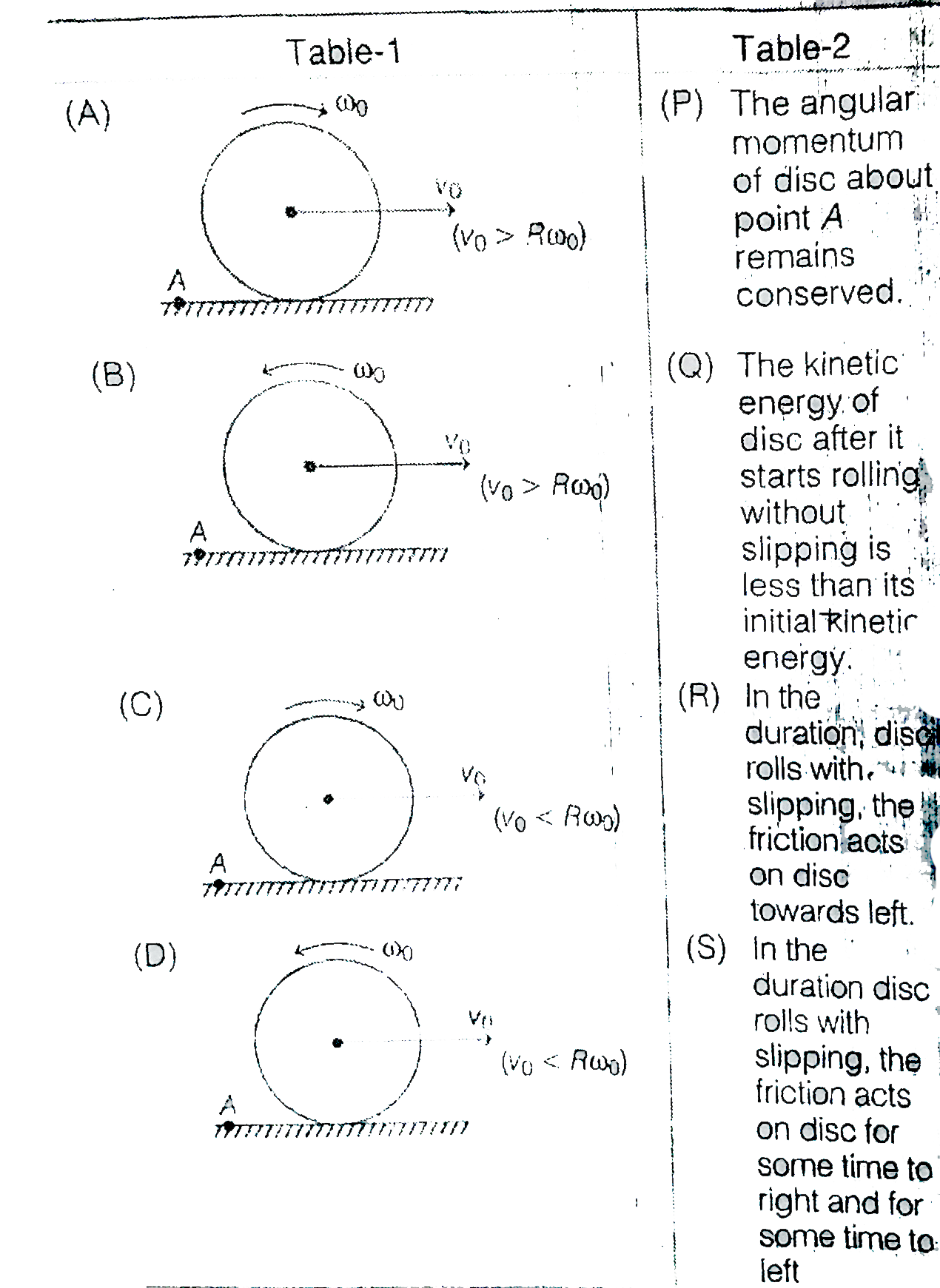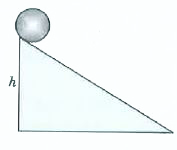A solid sphere, disc and hollow sphere are placed at the top of an inclined plane. Surface is sufficiently rough to provide pure rolling. All the objects are released from a state of rest
Solid sphere reaches the bottom first
Disc reaches the bottom first
Hollow sphere reaches the bottom first
All three objects reach the bottom simultaneously.
To determine which object (solid sphere, disc, or hollow sphere) will reach the bottom of an inclined plane first when released from rest, we can analyze the motion of each object using the principles of rotational motion and the concept of pure rolling.
1. Understanding the Forces and Motion:
- When an object rolls down an incline, it experiences a gravitational force acting downwards, which can be resolved into two components: one parallel to the incline (mg sin θ) and one perpendicular to the incline (mg cos θ).
- The frictional force is sufficient to ensure pure rolling, meaning the object rolls without slipping.
2. Setting Up the Equation of Motion:
- For pure rolling, the net torque (τ) acting on the object is given by τ = Iα, where I is the moment of inertia and α is the angular acceleration.
- The linear acceleration (a) of the center of mass is related to the angular acceleration by the equation: a = rα, where r is the radius of the object.
3. Applying Newton's Second Law:
- The equation of motion for the object can be expressed as:
mgsinθ−f=ma
- Here, f is the frictional force.
4. Relating Torque and Linear Acceleration:
- The torque due to the frictional force can be expressed as:
f⋅r=I⋅α
- Substituting α = a/r into the torque equation gives:
f⋅r=I⋅ar
- Rearranging this, we find:
f=I⋅ar2
5. Combining the Equations:
- Substitute f back into the equation of motion:
mgsinθ−I⋅ar2=ma
- Rearranging gives:
mgsinθ=ma+I⋅ar2
- Factor out a:
mgsinθ=a(m+Ir2)
- Thus, the acceleration a can be expressed as:
a=mgsinθm+Ir2
6. Calculating Moment of Inertia for Each Object:
- For a solid sphere: I=25mr2
- For a disc: I=12mr2
- For a hollow sphere: I=23mr2
7. Finding the Effective Mass for Each Object:
- Substitute the moments of inertia into the acceleration formula:
- Solid sphere:
a=mgsinθm+25m=mgsinθ75m=5gsinθ7
- Disc:
a=mgsinθm+12m=mgsinθ32m=2gsinθ3
- Hollow sphere:
a=mgsinθm+23m=mgsinθ53m=3gsinθ5
8. Comparing Accelerations:
- The solid sphere has the highest acceleration, followed by the disc, and then the hollow sphere:
- Solid sphere: 5gsinθ7
- Disc: 2gsinθ3
- Hollow sphere: 3gsinθ5
9. Conclusion:
- Since the solid sphere has the maximum acceleration, it will reach the bottom of the inclined plane first.
Final Answer:
The solid sphere will reach the bottom of the inclined plane first.
- When an object rolls down an incline, it experiences a gravitational force acting downwards, which can be resolved into two components: one parallel to the incline (mg sin θ) and one perpendicular to the incline (mg cos θ).
- The frictional force is sufficient to ensure pure rolling, meaning the object rolls without slipping.
- For pure rolling, the net torque (τ) acting on the object is given by τ = Iα, where I is the moment of inertia and α is the angular acceleration.
- The linear acceleration (a) of the center of mass is related to the angular acceleration by the equation: a = rα, where r is the radius of the object.
- The equation of motion for the object can be expressed as:
mgsinθ−f=ma
- Here, f is the frictional force.
- The torque due to the frictional force can be expressed as:
f⋅r=I⋅α
- Substituting α = a/r into the torque equation gives:
f⋅r=I⋅ar
- Rearranging this, we find:
f=I⋅ar2
- Substitute f back into the equation of motion:
mgsinθ−I⋅ar2=ma
- Rearranging gives:
mgsinθ=ma+I⋅ar2
- Factor out a:
mgsinθ=a(m+Ir2)
- Thus, the acceleration a can be expressed as:
a=mgsinθm+Ir2
- For a solid sphere: I=25mr2
- For a disc: I=12mr2
- For a hollow sphere: I=23mr2
- Substitute the moments of inertia into the acceleration formula:
- Solid sphere:
a=mgsinθm+25m=mgsinθ75m=5gsinθ7
- Disc:
a=mgsinθm+12m=mgsinθ32m=2gsinθ3
- Hollow sphere:
a=mgsinθm+23m=mgsinθ53m=3gsinθ5
- The solid sphere has the highest acceleration, followed by the disc, and then the hollow sphere:
- Solid sphere: 5gsinθ7
- Disc: 2gsinθ3
- Hollow sphere: 3gsinθ5
- Since the solid sphere has the maximum acceleration, it will reach the bottom of the inclined plane first.
The solid sphere will reach the bottom of the inclined plane first.
Topper's Solved these Questions
- SYSTEMS OF PARTICLES AND ROTATIONAL MOTIONBook:MODERN PUBLICATIONChapter:SYSTEMS OF PARTICLES AND ROTATIONAL MOTIONExercise:COMPETITION FILE ( OBJECTIVE TYPE QUESTIONS (JEE (Main) & Other State Boards for Engineering Entrance) )
Explore 48 Videos
- SYSTEMS OF PARTICLES AND ROTATIONAL MOTIONBook:MODERN PUBLICATIONChapter:SYSTEMS OF PARTICLES AND ROTATIONAL MOTIONExercise:COMPETITION FILE ( OBJECTIVE TYPE QUESTIONS MULTIPLE CHOICE QUESTIONS (with more than one correct answer) )
Explore 35 Videos
- SYSTEMS OF PARTICLES AND ROTATIONAL MOTIONBook:MODERN PUBLICATIONChapter:SYSTEMS OF PARTICLES AND ROTATIONAL MOTIONExercise:REVISION EXERCISES (Numerical Problems)
Explore 20 Videos
- PHYSICAL WORLD Book:MODERN PUBLICATIONChapter:PHYSICAL WORLD Exercise:Revision exercises (Long answer questions)
Explore 6 Videos
- THERMAL PROPERTIES OF MATTERBook:MODERN PUBLICATIONChapter:THERMAL PROPERTIES OF MATTERExercise:CHAPTER PRACTICE TEST
Explore 15 Videos
Similar Questions
A solid sphere, a ring and a disc all having same mass and radius are placed at the top of an incline and released. The friction coefficient between the objects and the incline are same but not sufficient to allow pure rolling. Least time will be taken in reaching the bottom by
View SolutionA ring, a solid cylinder and a solid sphere, all having same mass and radius, are placed at the top of an incline and released. The friction coefficents between the objects and the incline are same and not sufficient to allow pure rolling.
(a) Which body will reach the bottom first?
(b) Which body will have the minimum kinetic energy at the bottom?
View Solution
Knowledge Check
A solid sphere, disc and hollow sphere of same masa and radius are placed at the top of an inclined plane. Surface is sufficiently rough to provide pure rolling. All the objects are released from a state of rest.
ASolid sphere reaches the bottom firstBDisc reaches the bottom firstCHollow sphere reaches the bottom firstDAll three objects reach the bottom simultaneously.Two solid spheres P and Q are released from rest from the same point on an inclined plane. Plane is sufficiently rough to provide pure rolling Mass of P is greater than the mass of Q whereas radius of Q is greater than the radius of P
ABoth the spheres will reach the bottom simultaneouslyBSphere Preaches the bottom firstCSphere Q reaches the bottom firstDK.E. of P will be more than K.E. of Q when they reach the bottomA solid sphere, a hollow sphere and a disc, all having same mass and radius, are placed at the top of an incline and released. The friction coefficients between the objects and the incline are same and not sufficient to allow pure rolling. The smallest kinetic energy at the bottom of the incline will be achieved by
Athe solid sphereBthe hollow sphereCthe discDall will achieve same kinetic energy.
A solid sphere, a hollow sphere, a solid disc and a hollow cylinder are allowed to roll down a sufficiently rough inclined plane starting from rest. All have same mass and radius.

View SolutionA solid sphere , a hollow sphere and a disc , all having same mass and radius , are placed at the top of an incline and released . The friction coefficient between the objects and the incline are same and not sufficient to allow pure rolling . Prove that time taken in reaching the bottom is same for all .
View SolutionA solid sphere, a ring and a disc all having same mass and radius are placed at the top of an incline and released. The friction coefficient between the objects and the incline are same but not sufficient to allow pure rolling. Least time will be taken in reaching the bottom by
View SolutionA ring, cylinder and solid sphere are placed on the top of a rough incline on which the sphere can just roll without slipping. When all of them are released at the same instant from the same position, then
View SolutionSmall sphere of mass m and radius r is kept on fixed inclined rough surface. Surface makes an angle with the horizontal. Initially centre of sphere is at a height h above the horizontal floor. Coefficient of friction between the sphere and surface is u. Sphere is released from the state of rest.

Assume that friction is sufficiet enough to provide pure rolling. Speed of the sphere as it reaches the bottom is
View Solution

